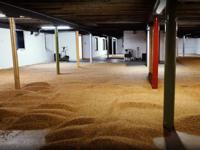TLDR
What is high diastic power?
Diastatic power (DP) refers to the enzymatic ability of a grain to break down its own starches into simpler sugars to enable fermentation during the mashing process. Grains with low diastatic power will not be able to fully utilise their own sugars and maximise alcohol yield unaided. For complete conversion of starch in to fermentable sugars, high levels of barley malt DP are important, especially when adding substantial amounts of unmalted barley or other grains to the mash.The Long Read
Contents

Diastatic Power (DP) is an important quality trait for malt used in adjunct brewing and distilling. For single malt production the DP of barley is more than sufficient to be used unaided, the same is not true for all other grains such as rye or wheat. For this reason US producers looking to make pure rye whiskies rely on the use of commercial enzymes. In other countries such as Scotland where the use of additive enzymes is not allowed, or more traditional producers a volume of high dp malted barley will be used instead.
What is malting and how does diastatic power come into it?
The malting process consists of placing raw barley grains in water and allowing these to germinate (begin sprouting or growing) until the acrospire (the small leaf growing inside the husk) reaches a length close to that of the grain itself. The malt is then kiln dried, and the tiny sproutlets fall off, leaving malted barley. The process is important because unmalted barley like other grains are made not of sugar but of more complex carbohydrate (starch) which cannot be digested by yeast to create alcohol.
The term diastatic refers to the two diastase enzymes. The first is alpha amylase and the second is beta amylase. These enzymes are the primary enzymes active when you mash your grains in the normal temperature range of 146F/63C and 156F/69C. During the malting process, endogenous proteolytic and amylolytic enzymes (either present within the mature grain or generated during germination) are released and modify the barley endosperm, with starch being converted into fermentable sugars.
Irish Single Pot Still Whiskey
In an attempt to extract higher taxes on distillation in Ireland the government introduced a malt tax in 1682. Rather than pay higher taxes the illicit distillers introduced a new type of whiskey the Irish Single Pot Still using only a percentage of malted barley and a mixture of unmalted barley and other grains.
This was possible because the high diastiatic power of the reduced amount of malted barley was still sufficient to break down the starches found in the other grains and ensure maximum alcohol extraction.
Grain whisky production
In grain whisky production, other unmalted cereals such as wheat or maize are used as the primary sources of carbohydrate (starch) and malted barley providing a small amount of carbohydrate but all of the enzymes. Soft wheat varieties have higher starch content than the hard wheat varieties and so have higher yields per tonne of grain used. The local availability of good quality distilling wheat and its relative cost continue to make this cereal attractive to distillers as a raw material.
However in order to achieve maximum yield from these grains barley with high nitrogen content and thus high diastatic power is required for the grain distilling process. Substantial genetic variation for DP exists within UK elite barley cultivars, but breeding progress has been slow due to the limited demand, compared to the overall barley market, and difficulties in assessing DP. For this reason the grain varietals used to make single malt will not be the same as those used for grain distillation.
How is diastatic power measured and calculated
Diastatic power is generally measured in degrees °Lintner per pound of grain in the US/UK and other english language countries, in europe °WK (Windisch-Kolbach) is measured. These are comparable as:
- °Lintner = (°WK+16)/3.5
- °WK = 3.5 x (°Lintner–16)
Malts with enough DP to convert themselves are at least 30 degrees Lintner or 89 °WK ; a grain bill that converts well in a 60 minute single infusion mash should have at least 70 degrees Lintner overall; base malts (malts used as a base along with specialty malts or unmalted grains that may not have enough enzymes to convert their own starches) such as those provided by the maltster Simpsons typically reach as high as 179 °Lintner.

